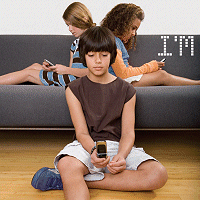What Students Want :: Leave Me Alone...I’m Socializing
##AUTHORSPLIT##<--->
Two opposing impulses are at the heartof kids' use of technology. But to hear themtell it, there's room for both.
 THE FOLLOWING STATEMENT will come as no surprise:Young people’s logic is hard to follow.
THE FOLLOWING STATEMENT will come as no surprise:Young people’s logic is hard to follow.
But at least now we have proof. Through conversations with students across different grade levels, we have clear evidence that two of the things kids most desire contradict each other— and they use electronic technology to get both of them.
Let’s begin exploring this phenomenon with the results of surveys conducted by the Consumer Electronics Association. Its most recent Teen Holiday Survey revealed that the top five gifts teenagers want are an MP3 player, a video-game console, a computer, a cell phone, and a portable game device. And its most recent Household Ownership Study disclosed that the top three consumer electronics purchases planned by teenagers are an MP3 player, a cell phone, and a video-game console.
Of all these products, one leaps out into the hearts and minds of adults who, more than anything, hope their children use new technologies to become better educated: the computer. There is no debating the enhancements that computer technology can offer to a student’s education.
Just ask the students themselves; they’ll tell you so. We spent time talking with three groups of kids in Seattle about their favorite electronic technologies, and any concerns they had related to those technologies. Enlightening us were Lowell Elementary School fifth-graders Lauren, Helena, Annie, Cole, Jahari, and Christopher; Washington Middle School eighth-graders Ellie, Naina, and Evelyn; and from Garfield High School, 11th and 12th-graders Travis, Zak, Sydney, and Caroline.
Tuning In, Tuning Out
All of the students we spoke to have computers and use them for educational purposes, more at home than in school. Of the Lowell Elementary kids, Jahari favors iQuest, a game-based system from LeapFrog with thousands of questions and answers relating to math, science, and social studies; Christopher does online research; Helena looks up words to enrich her vocabulary; and Cole makes a case for the educational benefits of RuneScape, an online game in which he learns about medieval customs and economics. The Washington Middle School students use “The Source,” a district-based website, to check up on homework assignments. Garfield High student Travis likes Wikipedia, the online encyclopedia. His classmate Sydney uses a variety of search engines to complete assignments.
But as much as students might benefit from all the resources at their fingertips, such as a download of the chronology of the Civil War, an Emerson essay, or a concise explanation of Planck’s constant, that’s not why they like their computers, or any of the other electronics they have around the house. From their responses, it seems that young people want technology because it secures two basic needs that, seemingly contradictory, are crucial to their well-being: to be left alone, and to connect with others.
Their favorite tool for receding into solitude seems to be Apple’s venerated MP3 player, the iPod. Eighth-grader Ellie says that when you put on headphones and listen to your favorite music, “you don’t have to think about things.” Her schoolmate Evelyn goes one step further: “It can change your mood.” Evelyn uses her iPod in situations such as “homework stress, family problems, if you’re annoyed with your parents, and if you’re in an enclosed place like your car.” She thinks that her peers use iPods more for escape than for constructive purposes.
BROWSING WITH CAUTION
Students know of the dangers lurking online,even if they aren’t at the top of their list ofconcerns. But one attempt at a kid-friendlysearch engine still needs work.
 Interestingly, our discussions with Seattle-area elementary, middle, andhigh school students revealed a lack of concern about the safety andprivacy issues related to internet use that so vex their parents. That’s notto say they aren’t aware of the dangers: "You have to be careful aboutwhat you say," fifth-grader Christopher says. His classmate Helena is protectedby parental controls. And another fifth-grader, Cole, says heknows not to give out his last name. The middle school kids have beenwarned about sexual predators. Naina is forbidden from using MySpace.Ellie uses MySpace, but she has a private account and has to approve"friends." Evelyn uses the internet just for homework. Meanwhile, thehigh school students were predictably blasé on the subject. Zak says, "Itnever really occurs to me."
Interestingly, our discussions with Seattle-area elementary, middle, andhigh school students revealed a lack of concern about the safety andprivacy issues related to internet use that so vex their parents. That’s notto say they aren’t aware of the dangers: "You have to be careful aboutwhat you say," fifth-grader Christopher says. His classmate Helena is protectedby parental controls. And another fifth-grader, Cole, says heknows not to give out his last name. The middle school kids have beenwarned about sexual predators. Naina is forbidden from using MySpace.Ellie uses MySpace, but she has a private account and has to approve"friends." Evelyn uses the internet just for homework. Meanwhile, thehigh school students were predictably blasé on the subject. Zak says, "Itnever really occurs to me."
Attempts have been made to make the online environment safer for students, to shield them from websites that may feature material unsuited for underage minds. For example, students using the Zoo.com search engine won’t come up with anything at all if they punch in "sex," "sexy," or even "breast." However, entering "copulation" will bring up any number of interesting and lurid websites, including one hosted by someone called "MC Copulation, a genius sex rapper." Moreover, the biases of the webmasters might be showing, since there doesn’t seem to be any filter at all when one enters "bloody" (you can read the description and view photos of a massacre in Ireland 25 years ago); "dismemberment" (you can view photos of the"remnants of a Phillipine woman, murdered and dismembered by her lover in late December 1920"); or "torture" (you can read a New Yorker article explicitly describing torture techniques). Evidently, some kinks need to be worked out. At least one site, Internet Filter Review (above), ranks filters such as ContentProtect, Cybersitter, and NetNanny based on their effectiveness, their ease of use, and their features.
Our fifth-graders sound less desperate. They don’t necessarily need a soporific, but they do like to absent themselves occasionally from the environment. Lauren is very specific about the advantages of an MP3 player: “I can listen in the car when I don’t want to listen to my brother’s music.” Cole says he mostly uses his iPod “as a substitute for reading, like on long car trips,” but he doesn’t think that his classmates are so angst-ridden that they turn to ear candy. Even senior Zak says that listening to his iPod is simply “something to do on bus rides.” To the extent that listening to one’s favorite music means not thinking about any sources of stress (see “Escape From What?”), iPods and the like are convenient escape routes. But what about the social isolation that comes from being electronically connected for so much of the time? Doesn’t this estrange young people from one another? What does it imply when someone prefers playing a video game or listening to music to talking with a friend?
Students seem to understand the risk, and have the proper perspective. Lowell Elementary’s Cole says, reasonably, that whether or not you’re isolated depends on how long you’re on the computer in comparison to how much time you spend with your friends. Christopher agrees that being electronically connected “can’t be more important than your friend.” Lauren relates the story of one girl who used to be her friend, but who now continually listens to her iPod on the bus: “Shedisappeared completely.”
Essays and articles aimed at parents propound the potential dangers of making the computer a best friend, and stand up for the irreplaceable connection that can only be made in the flesh. Penelope Trunk writes in the March 19, 2006, Boston Globe,“The human moment is a quality of interaction you don’t getfrom computers, or even the phone.” She quotes occupationaltherapist Jayme Lewin Rich: “In order to really converse withsomeone, you have to keep reading them—when they look atyou, when they smile, when they turn away.” Trunk adds,“Bonding hormones are higher when people are face-to-face.And some scientists think face-to-face contact stimulatesdopamine, the attention and pleasure neurotransmitter, andserotonin, the neurotransmitter that reduces fear and worry.”
BYTESIZE
The Consumer ElectronicsAssociation says that in2006, worldwide shipmentsof MP3 players were expectedto exceed 33 million.
Rising to their own defense, many of the students point out that some technologies in fact foster socializing. They say that e-mail, competitive video games, cell phones, and online networks such as MySpace enable contact when a face-to-face isn’t possible. “If you’re not at school, it’s hard to get together out of the blue,” eighth-grader Evelyn says. “Parents don’t like driving kids around. Lots of my friends live far away from me. I’d much rather be with them than talk with them, but it’s the next best thing.” She says that because she’s connected after school, the technology might displace family time, but not friend time.
High schooler Caroline won’t even grant that: “Being connected cuts you off from things, but not family or friends.” Sydney offers a different take, suggesting that online socialization and in-person socialization are different species. She used to be friends with someone online, but running into the person in school was awkward; trying to transport a virtual friendship into a real one can be jarring. As she says, “There are so many different ways to contact each other—IM, MySpace, cell phones. It depends on your relationship with that person.”

She disappearedcompletely.
— Lauren, Lowell Elementary School,
on a former friend who now continually
listens to her iPod
In opposition to Trunk’s analysis, some research supports this idea that technology facilitates, rather than obstructs, socialization. In an article for PBS.org, “Reality Bytes: Eight Myths About Video Games Debunked,” MIT Professor Henry Jenkins offers the following:
“Much video game play is social. Almost 60 percent of frequent gamers play with friends. Thirty-three percent play with siblings, and 25 percent play with spouses or parents. Even games designed for single players are often played socially, with one person giving advice to another holding a [controller]. A growing number of games are designed for multiple players— for either cooperative play in the same space or online play with distributed players.”
Throw in cell phones and e-mail, and you may be looking at the most social students in generations. A study called “Teens and Technology,” published by the Pew Internet & American Life Project, finds that “even with their great affection for technology, teens still report, on average, spending more time physically with their friends doing social things outside of school than they report interacting with friends through technology. An average youth between ages 12 and 17 reports spending 10.3 hours a week with friends doing social activities outside of school and about 7.8 hours talking with friends via technology like the telephone, e-mail, IM, or text messaging.” Granted, those figures may not factor in surreptitious, inappropriate uses of those technologies, such as in-class text messaging, which one student explains can be accomplished surreptitiously by setting one’s cell phone either to vibrate or to emit a high-pitched squeal that only young people can hear.
Student Wishlists
What electronic technologies do our surveyed students wish they had? Not surprisingly, the iPod is coveted across every grade. Jahari, Annie, Evelyn, and Sydney all want one. Not content with just the iPod, Jahari also wants a PSP, and Annie wants an iHome (Apple’s new home media center) and an i-Dog (a robotic dog from Hasbro that dances to the music coming from an MP3 player). As for the other fifth-graders, Lauren wants a “real computer” instead of her old iMac that apparently has seen better days. Helena would like a BlackBerry to keep her busy schedule, Cole a Nintendo Wii, and Christopher a laptop. Eighth-graders Ellie and Naina want cell phones for use after school. (Naina says that one time she was able to use her mother’s cell phone and, even though she had no one to call, brandished it conspicuously, punching numbers at random because “it made me feel special.”) In addition to a video iPod, Evelyn wants a Nintendo Wii. High schoolers Travis and Zak want iPhones.
We also asked the students what technologies they wish would be invented.
- Christopher would like a “more-than-virtual” helmet that puts the player “right into the game.”
- Helena would like something that can type whatever she is thinking.
- Annie wants a pocket computer.
- Evelyn imagines a shower stall/portal that would take her each morning from bed to school.
- Cole would like a time machine; on a more prosaic level, he’d settle for a slot in a computer that can expand or contract, depending on the size of the disk.
With kids’ lives now so entwined with technology, what were to happen if their favorite gadgets were suddenly unavailable? Our students got a taste of an unconnected life last winter when Seattle was beset by a massive windstorm, causing a loss of electricity for several days—no TV, no computers, no video games. Naina says she felt totally lost when her house went dead. And Caroline admits, “I was so bored. I couldn’t do anything. It showed me how dependent I am.” Her classmate Travis says that when his iPod recently broke, he had a difficult time adjusting: “I was obnoxious.”
ESCAPE FROM WHAT?
KIDS SAY THEY OFTEN use technologies such as the iPod toremove themselves from stressful circumstances. A May 2005article published by the American Academy of Child andAdolescent Psychiatry delineates the sourcesthat are causing so much teenage angst:
- school demands and frustrations
- negative thoughts and feelings about themselves
- changes in their bodies
- problems with friends and/or peers at school
- unsafe living environment/neighborhood
- separation or divorce of parents
- chronic illness or severe problems in the family
- death of a loved one
- moving or changing schools
- taking on too many activities or having too-high expectations
- family financial problems
Eighth-grader Evelyn says that participating in our survey did her some good: Until talking about it, she hadn’t realized how much technology she actually uses and how much a part of her life it is. Stopping to consider it, she concedes, “[It] can definitely get out of hand.”
:: web extra ::For more information on what students want, visit T.H.E. Journal. For more on a variety ofrelated topics, try the Browse by Topic menu.
Neal Starkman is a freelance writer based in Seattle.